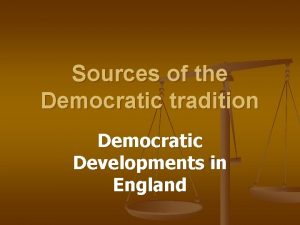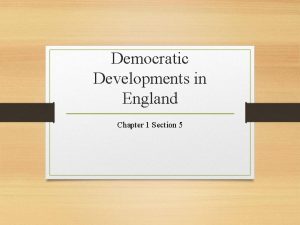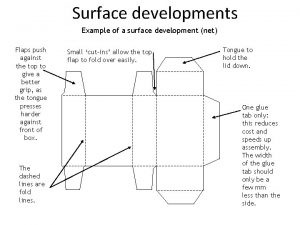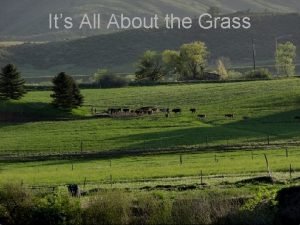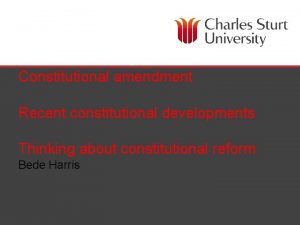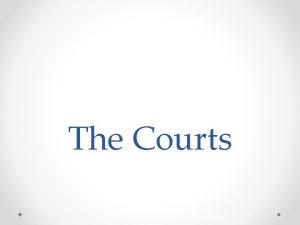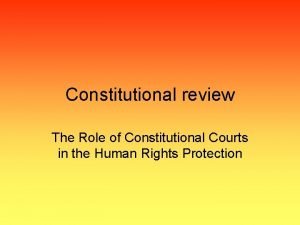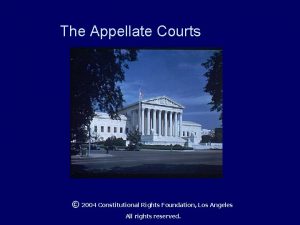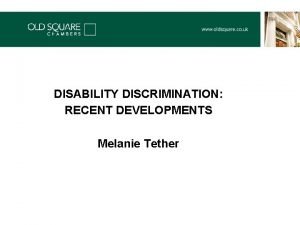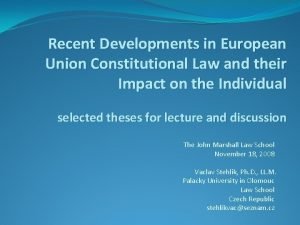RECENT CONSTITUTIONAL DEVELOPMENTS IN THE COURTS OF ENGLAND










![Not [presently] incorporated • Employment Tribunals • Employment Appeal Tribunal (appeal to Court of Not [presently] incorporated • Employment Tribunals • Employment Appeal Tribunal (appeal to Court of](https://slidetodoc.com/presentation_image_h2/7e7375c948693e1a2b15d6f2f6ce7ed5/image-11.jpg)

- Slides: 12

RECENT CONSTITUTIONAL DEVELOPMENTS IN THE COURTS OF ENGLAND & WALES Four Lectures delivered in the Law Faculty of the University of Trier by Dr Augur Pearce Cardiff University

Lecture 1 Tribunals in the Judicial System of England & Wales

The starting-point • Traditionally England & Wales have enjoyed a unitary court system – Dicey, Law of the Constitution, 1885, contrasted French administrative law with a system where ‘every man, whatever his rank or condition, is subject to the ordinary law and the jurisdiction of the ordinary courts’ – Administrative law has developed since the 1960 s in the Queen’s Bench Division of the High Court • Compare German Sozial-, Finanz-, Arbeits- and Verwaltungsgerichte

History of Tribunals • Slow beginnings – 1798 General Commissioners of Income Tax – 1911 Committee of Referees under the National Insurance Act – 1929 Attack by Lord Hewart CJ in The New Despotism – 1932 Donoughmore Report concludes undesirable but necessary – 1955 Franks Report concludes must be open, fair, impartial, but need not rely on adversarial principle

Arguments for Tribunals • Expertise – valuation, medical/psychiatric, labour conditions, &c. – not confined to decisions on evidence • Flexibility – no rules of precedent between coordinate tribunals – originally few decisions reported • Informality leads to speed, economy, popularity – hearsay not excluded, although ‘natural justice’ required – 670, 781 cases heard in tribunals in 2007

‘Judicialisation’ • Tribunals & Inquiries Act 1958 – Council on Tribunals established – Lord Chancellor’s involvement in appointment of Tribunal Chairmen – Duty to give reasons for decisions on request – Appeal to High Court on points of law • European Convention on Human Rights – Art 6: independent & impartial tribunal to determine civil rights & obligations

New developments • 2001: Leggatt Report recommends unified Tribunal service • 2006: extra-statutory creation of the service • 2007: Tribunals Courts and Enforcement Act – Part I aims: – assimilate practices & procedures – allow member-sharing – rationalise appeal routes efficiency, user-friendliness, new legal career path

New developments • 2007: Administrative Justice and Tribunals Council replaces Council on Tribunals • 2007: Lord Justice Carnwath appointed ‘Senior President of Tribunals’ – LCJ-equivalent in the Tribunal world, all-UK responsibilities • 2008: Senior President produces two ‘implementation reviews’ – judicial oath and titles for ‘Chairmen’ • 2008: New structure effective, 3 November

First-tier Tribunal • Social Entitlement Chamber – State benefits, criminal injuries compensation, gender recognition • Health, Education and Social Care Chamber – mental health review, special educational needs, disability • • War Pensions & Armed Forces Compensation Chamber Land, Property & Housing Chamber Taxation Chamber (from April 09) General Regulatory Chamber (from April 09)

Upper Tribunal • Finance & Tax Chamber • Lands Chamber • Administrative Appeals Chamber further appeal, with permission, to the Court of Appeal
![Not presently incorporated Employment Tribunals Employment Appeal Tribunal appeal to Court of Not [presently] incorporated • Employment Tribunals • Employment Appeal Tribunal (appeal to Court of](https://slidetodoc.com/presentation_image_h2/7e7375c948693e1a2b15d6f2f6ce7ed5/image-11.jpg)
Not [presently] incorporated • Employment Tribunals • Employment Appeal Tribunal (appeal to Court of Appeal) • Asylum & Immigration Tribunal (appeal to High Court) • Administrative Court (within High Court, QBD)

Conclusion • An end to the ‘Cinderella status’ of Tribunals • Perhaps an increased emphasis on Tribunals in English Legal System education?
 Recent developments in ict
Recent developments in ict Recent developments in object detection
Recent developments in object detection In the colonial era developments such as the new england
In the colonial era developments such as the new england Democratic developments in england
Democratic developments in england How did parliament emerged victorious in medieval england
How did parliament emerged victorious in medieval england When did england become a constitutional monarchy
When did england become a constitutional monarchy When did england become a constitutional monarchy
When did england become a constitutional monarchy Surface developments
Surface developments American grassfed association standards
American grassfed association standards Political developments in the early republic
Political developments in the early republic Ska developments
Ska developments Transmission developments
Transmission developments Patterns of development writing
Patterns of development writing



